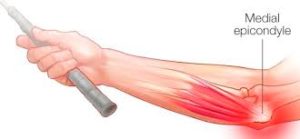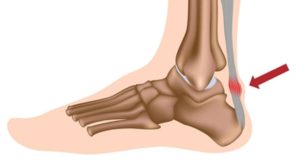What is tendinitis?
Tendinitis (also known as tendinopathy) is an inflammation of a tendon, a wide cord that attaches bone to muscle. This type of injury is normally caused by repetitive minor impact on the affected area or from a sudden more serious injury.
Incorrect posture at work or home or poor stretching before exercising can also increase your risk of tendinitis.
Tendinitis can affect most joints in the body, including ankles, elbows, knees, and shoulders. It is not age-specific, but it more common among adults who do a lot of sport. Older people are also at risk of tendinitis because the tendons tend to lose elasticity and become more fragile with age.
Compared to other body structures, tendons have a low blood supply and therefore can take a very long time to heal. The good news is that there is a wide range of treatment for tendinitis; from conservative management such as specific exercises to injections. The aim of these treatments is to reduce the inflammation, encourage tendon healing, and ultimately reduce pain and restore function.
The different types of tendinitis:
Elbow tendinitis or tennis elbow

It is a misconception that you can only get tennis elbow from playing tennis. This type of tendinitis is so-named so because it can affect a tendon that many tennis players use and injure repetitively.
Achilles tendinitis

This is an inflammation of the tendon connecting the lower calf muscles to the heel bone (calcaneus). This type of tendinitis is more common as people age, or in runners who have suddenly increased the intensity or duration of their runs. It’s also common in middle-aged people who play sports and do not sufficiently stretch before exercising.
Golfers elbow

This is a condition that causes pain where the tendons of your forearm muscles attach to the bony bump on the inside of your elbow. The pain can radiate into your forearm and wrist. This is a very similar condition to tennis elbow and it is also not exclusive to golfers. Rest and physiotherapy treatment can help you recover from this condition.
Trigger finger or thumb

Trigger finger is a painful condition in which your finger or thumb “catches” or gets locked in place when you bend or straighten it. While not a harmful condition, it can cause a lot of pain and discomfort.
Rotator cuff tendinitis

The rotator cuff in the shoulder is a group of muscles and tendons that keep the bone in the shoulder socket. We have four tendons in the rotator cuff that help with our shoulder movement and any one of them can become inflamed, injured, or swollen by repetitive movement or a traumatic injury.
Ankle peroneal tendinitis

Peroneal tendinitis is an irritation of the tendon that runs underneath the bony bump of the inner ankle. People with flat feet are more susceptible to this type of condition. Many suffer from this condition, especially long-distance runners.
Bicep tendinitis

Bicep tendinitis is an irritation of the tendon that connects the bicep muscle to the shoulder. It normally happens as a result of an injury caused by an overhead motion.
Wrist tendinitis

This is a common but painful condition. It is caused by irritation and inflammation of the tendons around the wrist joint. It can be irritated from a repetitive movement when playing sport or simply just working at the computer.
Patellar tendinitis

The kneecap (patella) is connected to the shin bone by the patellar tendon. Patellar tendinitis normally occurs among athletes, although this is not exclusive.
What are the early signs of tendinitis?
- Pain that worsens on movement
- A feeling that the tendon is crackling/grating as it moves
- Mild swelling or tendon thickening
- Stiffness and loss of movement may be more pronounced
What causes tendinitis?
Tendinitis often develops in people whose jobs or hobbies involve repetitive movements as this can aggravates the tendons. Other factors are:
- Sudden injury
- Repetition of a movement over time
- Age
- Sport
- Some health conditions. For example, people with diabetes and arthritis are more likely to develop tendinitis
How is tendinitis diagnosed?
A physiotherapist may ask you a number of questions and carry out some special tests to assist in their diagnosis. They will want to find out what could have brought it on and whether it is a specific injury or a repetitive movement. They will also assess your site of pain and may be able to locate localised tenderness and possible thickening or swelling of the affected tendon. Inflamed tendons are often seen on ultrasounds and MRI scans, which is why your physiotherapist may refer you to a specialist to confirm their diagnosis.
How is tendinitis treated?
Treatment goals are to relieve pain and reduce inflammation. These include:
- RICE (Rest, Ice, Compression, Elevation) for immediate treatment after an injury
- Heat therapy
- Resting the joint
- Activity modification
- Pain medication
- Physiotherapy, particularly stretches and eccentric exercises
- Deep tissue friction massage
- Splinting the affected joint
- Steroid or Plasma Rich Protein injections
- Surgical intervention (available as a last resort)
How physiotherapy can help your tendinitis
We will do whatever we can to get you on the fastest route to recovery. Some of the treatment methods we use include:
- Mobilisation
- Strengthening exercises
- Myofascial trigger point release
- Pilates
- Cross-friction massage
- Stretching and range of movement exercises
- Acupuncture
- Functional exercises
- Kinesio-taping
